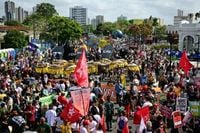As the early morning sun rose over Belém, Brazil, on November 14, 2025, dozens of members of the Indigenous Munduruku tribe gathered outside the venue of the United Nations’ COP30 climate summit. With determination etched on their faces, they blocked the entrance, demanding not only a meeting with President Luiz Inácio Lula da Silva but also urgent action against illegal gold mining and the rapid expansion of soybean transport infrastructure near their ancestral lands along the Tapajós River basin in the Amazon. The scene was a vivid reminder that, for many, the climate crisis isn’t just a matter of policy—it’s a fight for survival.
“Enough of using our image to claim sustainability and bio-economy while they destroy our forest,” declared Alessandra Korap, a prominent Munduruku leader and recipient of the 2023 Goldman Environmental Prize, according to reporting by Bloomberg. Her words cut through the noise of diplomatic pleasantries, highlighting a tension that has simmered beneath the surface of global climate talks for years: the gap between lofty promises and life on the ground for those most affected.
The 30th Conference of the Parties—better known as COP30—arrived at a pivotal moment, marking ten years since the Paris Agreement. The summit’s location, nestled near the edge of the Amazon rainforest, was more than symbolic. It was a clarion call for action, a reminder that the world’s largest tropical forest is both a vital carbon sink and home to communities whose fate is intertwined with the global climate. This year, the focus was on implementation. Gone were the days of mere pledges; the world’s eyes were on concrete action, with the hope that the summit would steer the planet closer to the 1.5°C warming threshold that scientists warn is critical.
Yet, as the talks began, the contrast in national approaches was stark. Canada arrived with a robust and inclusive delegation, led by Minister of Environment and Climate Change Julie Dabrusin. According to ClearBlue’s analysis, the Canadian team included Indigenous representatives, provincial leaders, and members of civil society, reflecting a commitment to both cooperation and diversity. Canada’s message was clear: economic growth and emissions reduction aren’t mutually exclusive, and market-based solutions can drive progress. The delegation’s active participation in initiatives such as the Declaration of the Open Coalition on Compliance Carbon Markets and the Coalition to Grow Carbon Markets underscored Canada’s intent to move from words to action.
Canada’s efforts at COP30 were closely tied to advancing Article 6 of the Paris Agreement, which aims to facilitate international cooperation through carbon markets. By backing initiatives focused on technology, finance, and cross-border partnerships, Canada sought to accelerate global progress toward that ever-elusive 1.5°C target. “Canada’s presence reflects a commitment to inclusivity and cooperation, with a diverse delegation including Indigenous representatives, civil society, and provincial leaders,” noted ClearBlue, highlighting the country’s blend of ambition and pragmatism.
In sharp contrast, the United States—the world’s second-largest emitter—was conspicuous in its absence at the federal level. The White House confirmed that no senior federal officials would attend COP30, a move consistent with the administration’s recent pivot back toward fossil fuel production and its controversial decision to withdraw from the Paris Agreement for a second time. As reported by ClearBlue, this absence “undermines global momentum by hindering the collective push for stronger Nationally Determined Contributions (NDCs) for 2035.” The decision sent ripples through the summit, creating a geopolitical vacuum and raising questions about who would step up to lead on climate finance and technology.
Yet, the American story at COP30 wasn’t entirely one of retreat. Over 100 sub-national leaders—including governors, mayors, and business executives—showed up in force, representing the “America Is All In” coalition. Among them was California Governor Gavin Newsom, whose state has long been at the forefront of climate policy. Just two months earlier, California had extended its landmark cap-and-trade program through 2045, rebranding it as Cap-and-Invest and tightening compliance requirements to better align with net-zero ambitions. This program now requires that compliance offsets be accounted for “under the cap,” effectively raising the bar for emissions reductions statewide.
These sub-national actors, representing nearly two-thirds of the U.S. population and three-quarters of its GDP, were determined to show that American climate action is far from dead. “Their presence at COP30 was designed to demonstrate that American climate action is still robust and continues on the ground, even without federal support,” ClearBlue observed. The message was unmistakable: while Washington may have stepped back, states and cities were forging ahead, seeking to keep the United States aligned with the spirit—if not the letter—of the Paris Agreement.
Meanwhile, the absence of U.S. federal leadership opened the door for other global players. With the U.S. on the sidelines, countries like China, the European Union, Brazil, and India found themselves with greater influence in shaping the summit’s outcomes—particularly on the thorny issues of climate finance and technological cooperation. For Brazil, hosting COP30 was both an honor and a challenge. The country sought to position itself as a leader of the global south, but the protests outside the summit’s doors were a stark reminder of the complexities at home.
For the Munduruku and other Indigenous groups, the stakes couldn’t be higher. The expansion of soybean transport infrastructure and the scourge of illegal gold mining threaten not only their lands but also the delicate balance of the Amazon ecosystem. As Alessandra Korap so pointedly put it, the use of Indigenous imagery to promote sustainability rings hollow when the reality is one of destruction. Their protest was a call to the world: listen to those who have protected these forests for generations.
As the conference drew to a close, the mood was a mix of cautious optimism and lingering frustration. Canada’s ambitious commitments, the vigor of U.S. sub-national actors, and the passionate voices of Indigenous leaders all offered hope that progress is possible. But the absence of U.S. federal leadership, persistent challenges in the Amazon, and the slow pace of global implementation served as sobering reminders that the path ahead is anything but straightforward.
Ultimately, COP30 in Belém was a microcosm of the global climate struggle—a place where promises and protests collided, and where the future of the planet hung in the balance. Whether the world will heed the lessons of the Amazon and move from pledges to real action remains to be seen, but one thing is clear: the voices demanding change are growing louder, and the stakes have never been higher.





